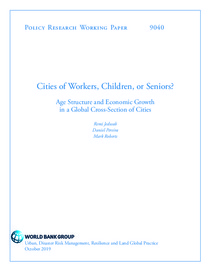Cities of workers, children, or seniors? Age structure and economic growth in a global cross-section of cities

Jedwab, Remi Camille ; Pereira, Daniel ; Roberts, Mark
World Bank - Washington, DC
2019
56 p.
urban area ; demographic aspect ; economic impact ; ageing population ; economic growth
Policy Research Working Paper
9040
Community, housing and urban questions
English
Bibliogr.
A large literature documents the positive influence of a city's skill structure on its rate of economic growth. By contrast, the effect of a city's age structure on its economic growth has been a hitherto largely neglected area of research. This paper hypothesizes that cities with more working-age adults are likely to grow faster than cities with more children or seniors. The paper sets out the potential channels through which such differential growth may occur. Using data from a variety of historical and contemporary sources, it shows that there exists marked variation in the age structure of the world's largest cities, across cities and over time. It then studies how age structure affects economic growth for a global cross-section of mega-cities. Using various identification strategies, the analysis finds that mega-cities with higher dependency ratios, that is, with more children and/or seniors per working-age adult, grow significantly slower. Such effects are particularly pronounced for cities with high shares of children. This result appears to be driven mainly by the direct, negative effects of a higher dependency ratio on the size of the working-age population and the indirect effects on work hours and productivity for working-age adults within a city."
Digital
The ETUI is co-funded by the European Union. Views and opinions expressed are however those of the author(s) only and do not necessarily reflect those of the European Union or the ETUI.